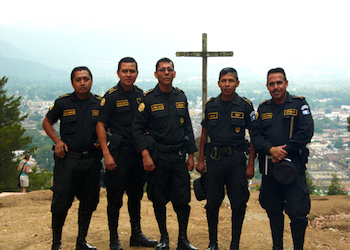In our May 4 Facebook Live session, Co-director Steven Dudley spoke with Senior Edior Mike LaSusa about InSight Crime’s most recent special investigation on homicides in Guatemala. Dudley summarized the results of the investigation in a blog post for InSight Crime’s partner, the Center for Latin American and Latino Studies at American University. That blog post is reproduced below, along with the full video of our Facebook Live discussion.
A study of hundreds of homicides in Guatemala revealed major problems with authorities’ contention that “gang-related” and “drug trafficking-related” murders are at the center of the violence in that country, findings that complicate violence reduction programs in that country and elsewhere. InSight Crime analyzed the murders in two areas: Zona 18 in Guatemala City, where 300,000 inhabitants live in what authorities designate a “gang area,” and the municipality of Chiquimula, a community of some 100,000, or what authorities call a “trafficking corridor.” We also studied how police, forensic doctors, and government prosecutors gather and use information they gather during homicide investigations to clear cases or not. It is less CSI and more creaky, antiquated 20th century bureaucracy.
Key findings from the report include:
- The confidence with which Guatemalan authorities attribute homicides to traffickers is not warranted by the available facts. In the trafficking corridor, we could reasonably attribute only 28 percent of the homicides to what we termed “organized crime-related” activities — significantly less than authorities normally publicly attribute to organized crime. Drug trafficking, we believe, is an incorrect way of describing the dynamics behind this violence. Another 38 percent of the cases lacked information to make a determination.
- In the gang area, where Barrio 18 and Mara Salvatrucha (MS13) operate, we could reasonably attribute 41 percent of the homicides to gang-related activities — an estimate in line with what authorities say in Guatemala. Another 35 percent of the cases did not have enough information to make a determination.
- Regardless of area, the widespread availability of firearms is a clear factor in the murder rate. An estimated 75 percent of all homicides occur at the end of a gun in Guatemala. At 15.8 guns per 100 inhabitants, the country has the highest number of guns per capita in the region, according to World Bank data. (El Salvador has 7.0 per 100, and Honduras, 6.2.).
- Another theory to explain the level of homicides — that the more “indigenous” western highlands are less prone to violence than the more “ladino” eastern states — is in its infancy and beyond the scope of our study.
In both areas, the information from authorities was fragmented, disorganized, and sometimes missing altogether. Reports are filled out by hand or typed into computers, but they are quickly buried in massive piles of data and are most likely erased or lost by the next person in that job. Multiple, clashing bureaucracies operating on the different platforms and with different formats also have differing criteria for classifying data. The low priority given to collecting and analyzing information, and poor training, seriously undermine authorities’ ability to understand the homicide phenomenon as well as resolve the homicide cases themselves. Indeed, our observation is that the resources used to gather what are considered more politically salient statistics — such as the overall number of criminal acts in any one area — hurts efforts to resolve cases or give authorities the ability to analyze criminal dynamics.
SEE ALSO: Guatemala News and Profile
The confusion between the sources of violence has a palpable impact on how money is allocated over the years. The US Congressional Research Service has estimated that 66 percent of the $1.2 billion that Washington disbursed under its Central America Regional Security Initiative (CARSI) was “hard-side” assistance aimed at attacking drug traffickers whose role in the murder rate we have assessed to be lower than previously thought. Only 31 percent of US aid was “soft assistance” — violence prevention, social and economic programs — that would address the more serious problem of gang violence. The allocation of Guatemala’s own funding is harder to discern, but the Mano Dura tactics adopted by the Northern Triangle countries over the years have more resembled the militarized strategy against the drug traffickers, implementing various states of siege in affected locales (Guatemala), enacting “emergency measures” inside jails and in particularly troublesome states (El Salvador), and using the military police in numerous places (Honduras). Aggressive police sweeps have, moreover, overcrowded prisons bursting with inmates in horrifying conditions. While some of these programs may have helped slow the increase in homicides, our report clearly indicates that a deeper understanding of the problem — based on more rigorous collection and analysis of information on homicide cases — is necessary to evaluate and improve international and local strategies. Especially if Washington cuts Northern Triangle funding, as it is widely reported to be intending, a smarter approach will require becoming smarter about the problem.
Watch the Facebook Live broadcast for the full conversation:
* The blog post above was authored by Steven Dudley and was reproduced with the permission of American University’s Center for Latin American and Latino Studies. See the original here.

